The Relationship between the Built Environment and Climate Change: The Case of Turkish Provinces
Abstract
:1. Introduction
2. Data and Methodology
3. Results
4. Conclusions
Author Contributions
Funding
Institutional Review Board Statement
Informed Consent Statement
Data Availability Statement
Conflicts of Interest
References
- Dale, V.H. The relationship between land-use change and climate change. Ecol. Appl. 1997, 7, 753–769. [Google Scholar] [CrossRef]
- Wilby, R.L. A review of climate change impacts on the built environment. Built Environ. 2007, 33, 31–45. [Google Scholar] [CrossRef] [Green Version]
- Zhang, P.; Li, Y.; Jing, W.; Yang, D.; Zhang, Y.; Liu, Y.; Geng, W.; Rong, T.; Shao, J.; Yang, J.; et al. Comprehensive assessment of the effect of urban built-up land expansion and climate change on net primary productivity. Complexity 2020, 2020, 8489025. [Google Scholar] [CrossRef]
- T.R. The Ministry of Environment, Urbanization and Climate Change, Directorate of Environmental Impact Assessment, Permit and Inspection, Çevresel Göstergeler. (Yayın No. 49-1). 2020. Available online: https://ced.csb.gov.tr/cevresel-gostergeler-kitapcigi-i-82681 (accessed on 27 May 2021).
- Resilience Alliance. Urban Resilience Research Prospectus. Resource Document. Resilience Alliance. 2007. Available online: http://www.resalliance.org/1610.php (accessed on 1 January 2021).
- Pielke, R.A.; Marland, G.; Betts, R.A.; Chase, T.N.; Eastman, J.L.; Niles, J.O.; Niyogi D dutta, S.; Running, S.W. The influence of land-use change and landscape dynamics on the climate system: Relevance to climate-change policy beyond the radiative effect of greenhouse gases. Philos. Trans. R. Soc. London. Ser. A Math. Phys. Eng. Sci. 2002, 360, 1705–1719. [Google Scholar] [CrossRef] [PubMed]
- Mendelsohn, R.; Dinar, A. Land use and climate change interactions. Annu. Rev. Resour. Econ. 2009, 1, 309–332. [Google Scholar] [CrossRef]
- Şen, Z. İklim Değişikliği Tatlı Su Kaynakları ve Türkiye (Climate Change, Fresh Water Resources and Türkiye); Su Vakfı: Istanbul, Turkiye, 2009. (In Turkish) [Google Scholar]
- House-Peters, L.A.; Chang, H. Modeling the impact of land use and climate change on neighborhood-scale evaporation and nighttime cooling: A surface energy balance approach. Landsc. Urban Plan. 2011, 103, 139–155. [Google Scholar] [CrossRef]
- Kaplan, J.O.; Krumhardt, K.M.; Zimmermann, N.E. The effects of land use and climate change on the carbon cycle of Europe over the past 500 years. Glob. Change Biol. 2012, 18, 902–914. [Google Scholar] [CrossRef]
- Tran, D.X.; Pla, F.; Latorre-Carmona, P.; Myint, S.W.; Caetano, M.; Kieu, H.V. Characterizing the relationship between land use land cover change and land surface temperature. ISPRS J. Photogramm. Remote Sens. 2017, 124, 119–132. [Google Scholar] [CrossRef] [Green Version]
- Doelman, J.C.; Stehfest, E.; Tabeau, A.; van Meijl, H.; Lassaletta, L.; Gernaat, D.E.H.J.; Hermans, K.; Harmsen, M.; Daioglou, V.; Biemans, H.; et al. Exploring SSP land-use dynamics using the IMAGE model: Regional and gridded scenarios of land-use change and land-based climate change mitigation. Glob. Environ. Change 2018, 48, 119–135. [Google Scholar] [CrossRef] [Green Version]
- Nobre, C.A.; Sellers, P.J.; Shukla, J. Amazonian deforestation and regional climate change. J. Clim. 1991, 4, 957. [Google Scholar] [CrossRef]
- Dickinson, R.E.; Kennedy, P. Impacts on regional climate of Amazon deforestation. Geophys. Res. Lett. 1992, 19, 1947–1950. [Google Scholar] [CrossRef] [Green Version]
- Costa, M.H.; Foley, J.A. Combined effects of deforestation and doubled atmospheric co2 concentrations on the climate of Amazonia. J. Clim. 2000, 13, 17. [Google Scholar] [CrossRef]
- Pielke, R.A. Land use as climate change. Science 2005, 310, 1625–1626. [Google Scholar] [CrossRef] [Green Version]
- Satterthwaite, D. The implications of population growth and urbanization for climate change. Environ. Urban. 2009, 21, 545–567. [Google Scholar] [CrossRef] [Green Version]
- Rienow, A.; Kantakumar, L.N.; Ghazaryan, G.; Dröge-Rothaar, A.; Sticksel, S.; Trampnau, B.; Thonfeld, F. Modelling the spatial impact of regional planning and climate change prevention strategies on land consumption in the Rhine-Ruhr Metropolitan Area 2017–2030. Landsc. Urban Plan. 2022, 217, 104284. [Google Scholar] [CrossRef]
- Pitman, A.J.; de Noblet-Ducoudré, N.; Cruz, F.T.; Davin, E.L.; Bonan, G.B.; Brovkin, V.; Claussen, M.; Delire, C.; Ganzeveld, L.; Gayler, V.; et al. Uncertainties in climate responses to past land cover change: First results from the LUCID intercomparison study. Geophys. Res. Lett. 2009, 36, L14814. [Google Scholar] [CrossRef] [Green Version]
- Ehrlich, D.; Kemper, T.; Pesaresi, M.; Corbane, C. Built-up area and population density: Two Essential Societal Variables to address climate hazard impact. Environ. Sci. Policy 2018, 90, 73–82. [Google Scholar] [CrossRef]
- Verdonck, M.-L.; Demuzere, M.; Hooyberghs, H.; Beck, C.; Cyrys, J.; Schneider, A.; Dewulf, R.; Van Coillie, F. The potential of local climate zones maps as a heat stress assessment tool, supported by simulated air temperature data. Landsc. Urban Plan. 2018, 178, 183–197. [Google Scholar] [CrossRef]
- EPA-Environment Protection Agency. Climate Change Indicators in The United States (Fourth Edition). 2016. Available online: https://www.epa.gov/sites/default/files/2021-02/documents/climate_indicators_2016.pdf (accessed on 1 July 2021).
- Rovers, V.; Bosch, P.; Albers, R. Final Report Climate Proof Cities 2010–2014. 2014. Available online: https://klimaatadaptatienederland.nl/en/themes-sectors/themes/climate-change/ (accessed on 23 May 2021).
- EEA-European Environment Agency. Europe’s Changing Climate Hazards-An Index-Based Interactive EEA Report. 2021. Available online: https://www.eea.europa.eu/downloads/163297bf75d54a45a1dcbe5d8ce1d9fe/1637331959/climate-hazards-indices.pdf (accessed on 23 May 2021).
- THCA (Turkish Healthy Cities Association). COP24 Special Report, Sağlık ve İklim Değişikliği. 2020. Available online: https://apps.who.int/iris/bitstream/handle/10665/276405/9786057496713-tur.pdf (accessed on 27 May 2021).
- NAS (National Adaptation Strategy). National Climate Adaptation Strategy. 2016. Available online: https://nas-adaptatietool.nl/ (accessed on 27 May 2021).
- EEA-European Environment Agency. National and Transnational Climate Atlases in Europe. 2021. Available online: https://www.eea.europa.eu/publications/europes-changing-climate-hazards-1/national-and-transnational-climate-atlases/view (accessed on 27 May 2021).
- Brovkin, V.; Boysen, L.; Arora, V.K.; Boisier, J.P.; Cadule, P.; Chini, L.; Claussen, M.; Friedlingstein, P.; Gayler, V.; van den Hurk, B.J.J.M.; et al. Effect of anthropogenic land-use and land-cover changes on climate and land carbon storage in CMIP5 projections for the twenty-first century. J. Clim. 2013, 26, 6859–6881. [Google Scholar] [CrossRef]
- Gülbaz, S.; Kaya, Y.E.; Alhan, C.M.K. Düşük etkili kentleşme uygulamalarının yüzeysel akışa etkisi: İstanbul üniversitesi avcılar kampüsü örneği (The Impact of LID Implementation on Surface Runoff: Case Study of Istanbul University, Avcılar Campus). İklim Değişikliği Ve Çevre 2018, 3, 45–50. (In Turkish) [Google Scholar]
- Zhao, G.; Gao, H.; Cuo, L. Effects of urbanization and climate change on peak flows over the San Antonio River Basin, Texas. J. Hydrometeorol. 2016, 17, 2371–2389. [Google Scholar] [CrossRef]
- Argüeso, D.; Evans, J.P.; Fita, L.; Bormann, K.J. Temperature response to future urbanization and climate change. Clim. Dyn. 2014, 42, 2183–2199. [Google Scholar] [CrossRef]
- Chapman, S.; Watson, J.E.M.; Salazar, A.; Thatcher, M.; McAlpine, C.A. The impact of urbanization and climate change on urban temperatures: A systematic review. Landsc. Ecol. 2017, 32, 1921–1935. [Google Scholar] [CrossRef]
- Lin, L.; Ge, E.; Liu, X.; Liao, W.; Luo, M. Urbanization effects on heat waves in Fujian Province, Southeast China. Atmos. Res. 2018, 210, 123–132. [Google Scholar] [CrossRef]
- Qiu, J.; Yang, X.; Cao, B.; Chen, Z.; Li, Y. Effects of urbanization on regional extreme-temperature changes in China, 1960–2016. Sustainability 2020, 12, 6560. [Google Scholar] [CrossRef]
- Orhan, O. Mersin ilindeki kentsel büyümenin yer yüzey sıcaklığı üzerine etkisinin araştırılması (Investigation of the effect of urban expansion on surface temperature in Mersin city). Geomatik 2021, 6, 69–76. (In Turkish) [Google Scholar]
- Bradshaw, C.J.A.; Sodhi, N.S.; Peh, K.S.-H.; Brook, B.W. Global evidence that deforestation amplifies flood risk and severity in the developing world. Glob. Change Biol. 2007, 13, 2379–2395. [Google Scholar] [CrossRef]
- Chang, H.; Franczyk, J. Climate Change, land-use change, and floods: Toward an integrated assessment: Climate change, land-use change, and floods. Geogr. Compass 2008, 2, 1549–1579. [Google Scholar] [CrossRef]
- Zhou, Q.; Leng, G.; Su, J.; Ren, Y. Comparison of urbanization and climate change impacts on urban flood volumes: Importance of urban planning and drainage adaptation. Sci. Total Environ. 2019, 658, 24–33. [Google Scholar] [CrossRef]
- Lin, L.; Gao, T.; Luo, M.; Ge, E.; Yang, Y.; Liu, Z.; Zhao, Y.; Ning, G. Contribution of urbanization to the changes in extreme climate events in urban agglomerations across China. Sci. Total Environ. 2020, 744, 140264. [Google Scholar] [CrossRef]
- Oruç, S.; Yücel, İ.; Yılmaz, A. İklim Değişikliği, Ekstrem Yağışlar ve Etkileri: Etimesgut, Ankara Örneği (Climate Change, Extreme Rainfall and Its Effects: The Case of Etimesgut, Ankara). In Proceedings of the 10. Ulusal Hidroloji Kongresi, Muğla, Turkiye, 9–12 October 2019. (In Turkish). [Google Scholar]
- Kadıoğlu, M. Sellere dirençli kent oluşturmanın adımları (Steps to build a flood resilience city). Şehir ve Toplum 2018, 10, 77–89. (In Turkish) [Google Scholar]
- Kazancı, G. İklim Değişikliğine Uyum Kapsamında Akıllı Kentlerin Rolü: Muğla Metropoliten Alanı Üzerine Bir Değerlendirme (The Role of Smart Cities Under the Adaptation into Climate Change: An Evaluation on Mugla Metropolitan Area); Yüksek Lisans Tezi; İstanbul Teknik Üniversitesi: Istanbul, Turkiye, 2019. (In Turkish) [Google Scholar]
- Karacan, G. Kentsel Iklim Değişikliği Kapsamında Sera Gazı Azaltım Stratejileri; Ankara Örneği (Greenhouse Gas Reduction Strategies In The Context of Urban Climate Change; Case of Ankara); Yüksek Lisans Tezi; Süleyman Demirel Üniversitesi: Isparta, Turkiye, 2020. (In Turkish) [Google Scholar]
- Onur, A.C.; Tezer, A. Ecosystem services based spatial planning decision making for adaptation to climate changes. Habitat Int. 2015, 47, 267–278. [Google Scholar] [CrossRef]
- Balaban, O. İklim Değişirken Kent ve Kentleşme (City and Urbanization as the Climate Changes). In Proceedings of the 2023 Türkiye’si Sempozyumu, Ankara, Turkiye, 26–28 April 2018. (In Turkish). [Google Scholar]
- Stone, B. Land use as climate change mitigation. Environ. Sci. Technol. 2009, 43, 9052–9056. [Google Scholar] [CrossRef]
- Kotharkar, R.; Bagade, A. Evaluating urban heat island in the critical local climate zones of an Indian city. Landsc. Urban Plan. 2018, 169, 92–104. [Google Scholar] [CrossRef]
- Tezer, A.; Kazancı, G. İklim değişikliğine uyum konusunda öne çıkan mekânsal planlama kriterleri (Spatial planning criteria for adaptation to climate change). Mimar. Ve Mühendis Derg. 2019, 31, 90–94. (In Turkish) [Google Scholar]
- Büttner, G.; Kosztra, B.; Maucha, G.; Pataki, R.; Kleeschulte, S.; Hazeu, G.; Vittek, M.; Schröder, C.; Littkopf, A. Copernicus Land Monitoring Service CORINE Land Cover-User Manual; European Environment Agency: Copenhagen, Denmark, 2021. [Google Scholar]
- Kozstra, B.; Büttner, G.; Hazeu, G.; Arnold, S. Updated CLC Illustrated Nomen-Clature Guidelines; European Environment Agency: Copenhagen, Denmark, 2017; pp. 1–124. Available online: https://land.copernicus.eu/user-corner/technical-library/corine-land-cover-nomenclature-guidelines/docs/pdf/CLC2018_Nomenclature_illustrated_guide_20190510.pdf (accessed on 27 May 2021).
- Mirza, M.M.Q. Climate change and extreme weather events: Can developing countries adapt? Clim. Policy 2003, 3, 233–248. [Google Scholar] [CrossRef]
- Huber, D.G.; Gulledge, J. Extreme Weather and Climate Change: Understanding the Link, Managing the Risk; Pew Center on Global Climate Change: Arlington, TX, USA, 2011. [Google Scholar]
- Stott, P. How climate change affects extreme weather events. Science 2016, 352, 1517–1518. [Google Scholar] [CrossRef]
- McKee, T.B.; Doesken, N.J.; Kleist, J. The relationship of drought frequency and duration to time scales. In Proceedings of the 8th Conference on Applied Climatology, Anaheim, CA, USA, 17–22 January 1993. [Google Scholar]
- European Comission. Standardized Precipitation Index (SPI). European Drought Observatory Indicator Factsheet; European Comission: Brussels, Belgium, 2020. [Google Scholar]
- Sonmez, F.K.; Komuscu, A.U.; Erkan, A.; Turgu, E. An analysis of spatial and temporal dimension of drought vulnerability in Turkey using the standardized precipitation index. Nat. Hazards 2005, 35, 243–264. [Google Scholar] [CrossRef]
- Salehnia, N.; Alizadeh, A.; Sanaeinejad, H.; Bannayan, M.; Zarrin, A.; Hoogenboom, G. Estimation of meteorological drought indices based on AgMERRA precipitation data and station-observed precipitation data. J. Arid. Land. 2017, 9, 797–809. [Google Scholar] [CrossRef] [Green Version]
- WMO—World Meteorological Organization. Standardized Precipitation Index User Guide; (WMO-No. 1090); WMO: Geneva, Switzerland, 2012. [Google Scholar]
- Caloiero, T.; Veltri, S.; Caloiero, P.; Frustaci, F. Drought analysis in Europe and in the Mediterranean basin using the standardized precipitation index. Water 2018, 10, 1043. [Google Scholar] [CrossRef] [Green Version]
- Kahane, L.H. Regression Basics, 2nd ed.; Sage Publication: London, UK, 2008. [Google Scholar]
- Motulsky, H.; Christopoulos, A. Fitting Models to Biological Data Using Linear and Nonlinear Regression: A Practical Guide to Curve Fitting, 1st ed.; Oxford University Press: Oxford, UK, 2014. [Google Scholar]
- Montgomery, D.C.; Peck, E.A.; Vining, G.G. Introduction to Linear Regression Analysis; John Wiley & Sons: Hoboken, NJ, USA, 2021. [Google Scholar]
- Moore, D.S.; McCabe, G.P.; Craig, B.A. Introduction to the Practice of Statistics, 8th ed; W.H. Freeman and Company: New York, NY, USA, 2014. [Google Scholar]
- Casson, R.J.; Farmer, L.D. Understanding and checking the assumptions of linear regression: A primer for medical researchers. Clin. Exp. Ophthalmol. 2014, 42, 590–596. [Google Scholar] [CrossRef] [PubMed]
- Li, H.; Zhou, Y.; Wei, Y.D. Institutions, extreme weather, and urbanization in the Greater Mekong Region. Ann. Am. Assoc. Geogr. 2019, 109, 1317–1340. [Google Scholar] [CrossRef]
- Oke, T.R. The energetic basis of the urban heat island. Q. J. R. Meteorol. Soc. 1982, 108, 1–24. [Google Scholar] [CrossRef]
- Hale, R.C.; Gallo, K.P.; Loveland, T.R. Influences of specific land use/land cover conversions on climatological normals of near-surface temperature. J. Geophys. Res. 2008, 113, D14113. [Google Scholar] [CrossRef]
- Rosner, B. Fundamentals of Biostatistics, 8th ed.; Cengage Learning: Boston, MA, USA, 2016. [Google Scholar]
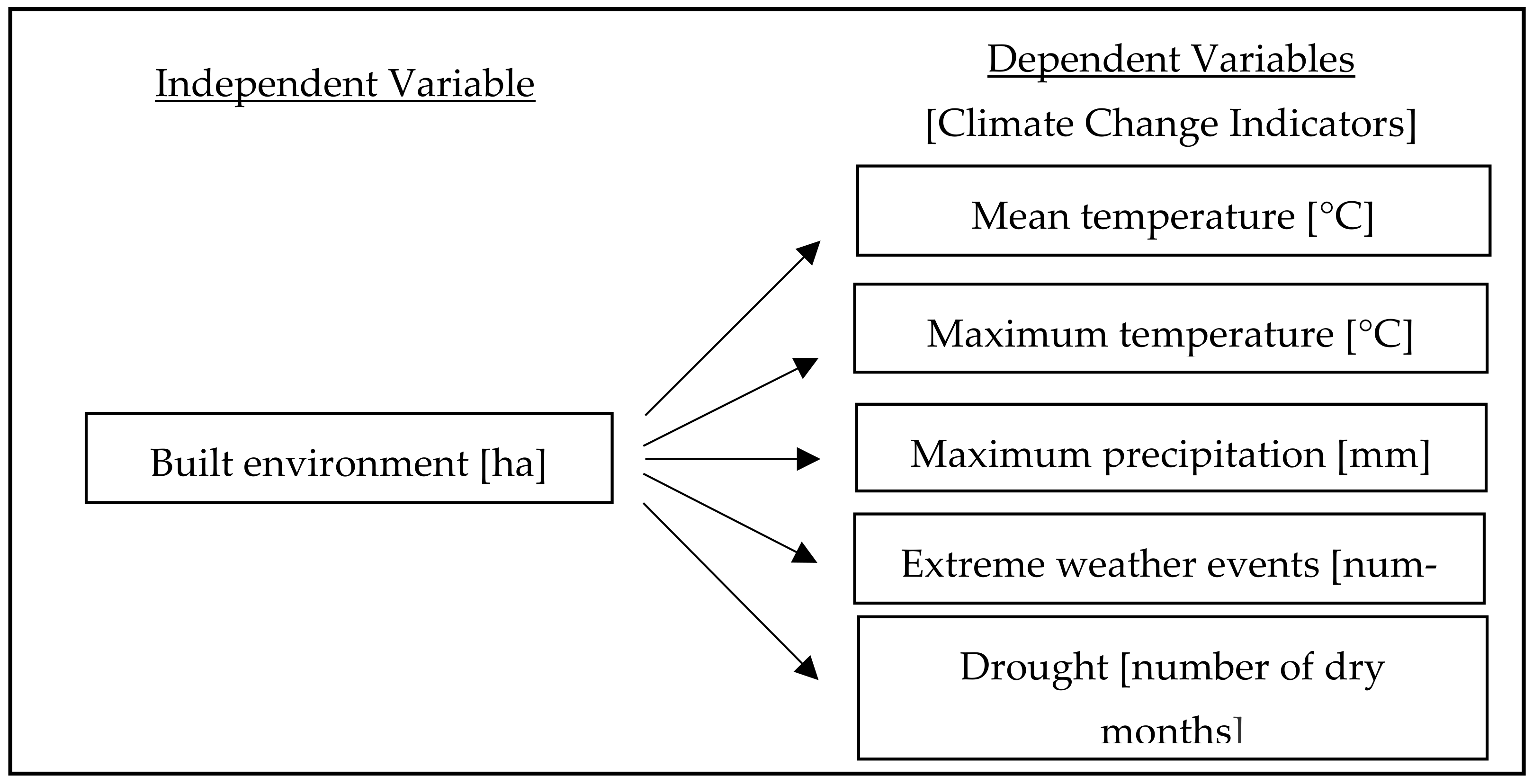

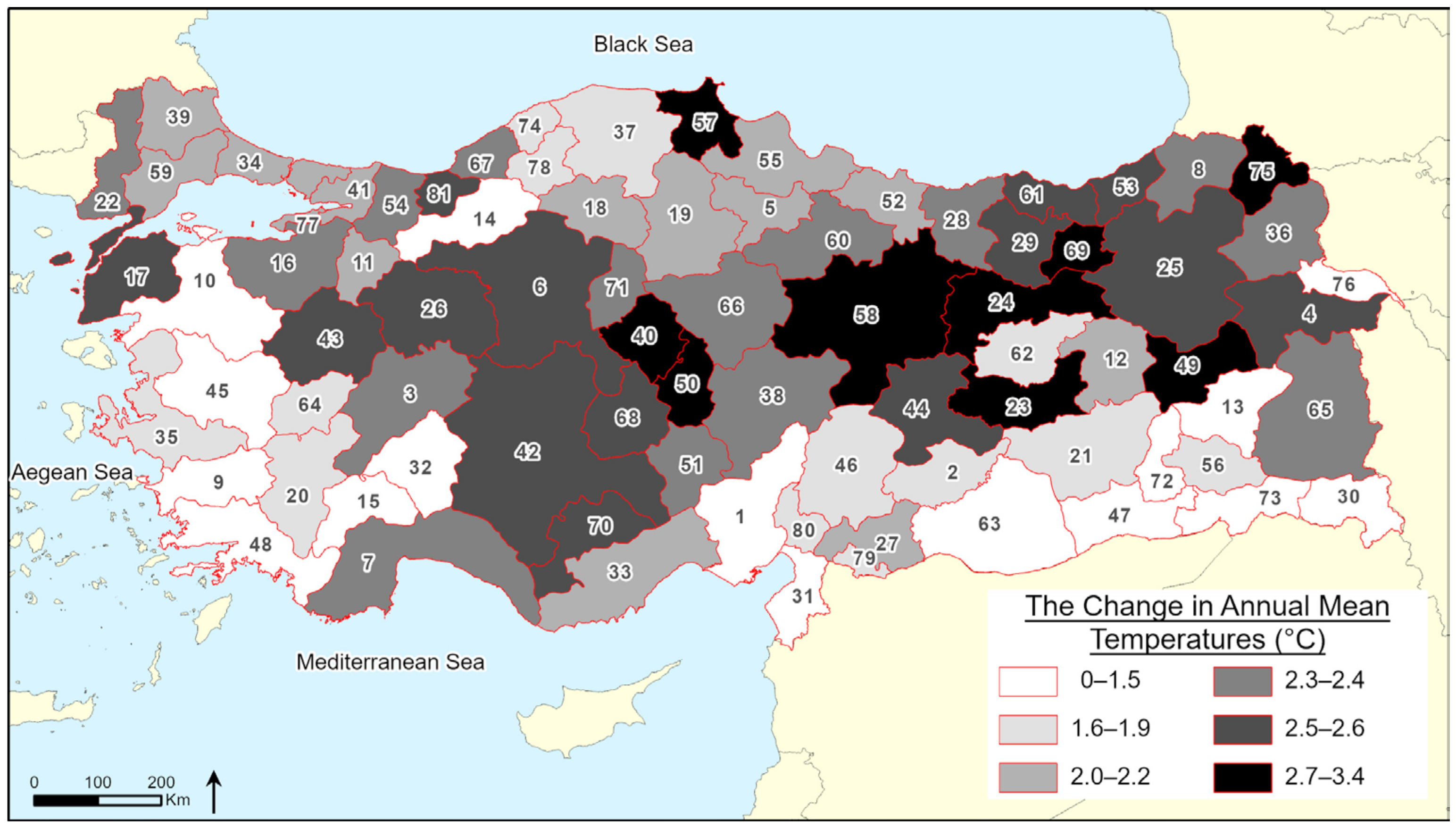
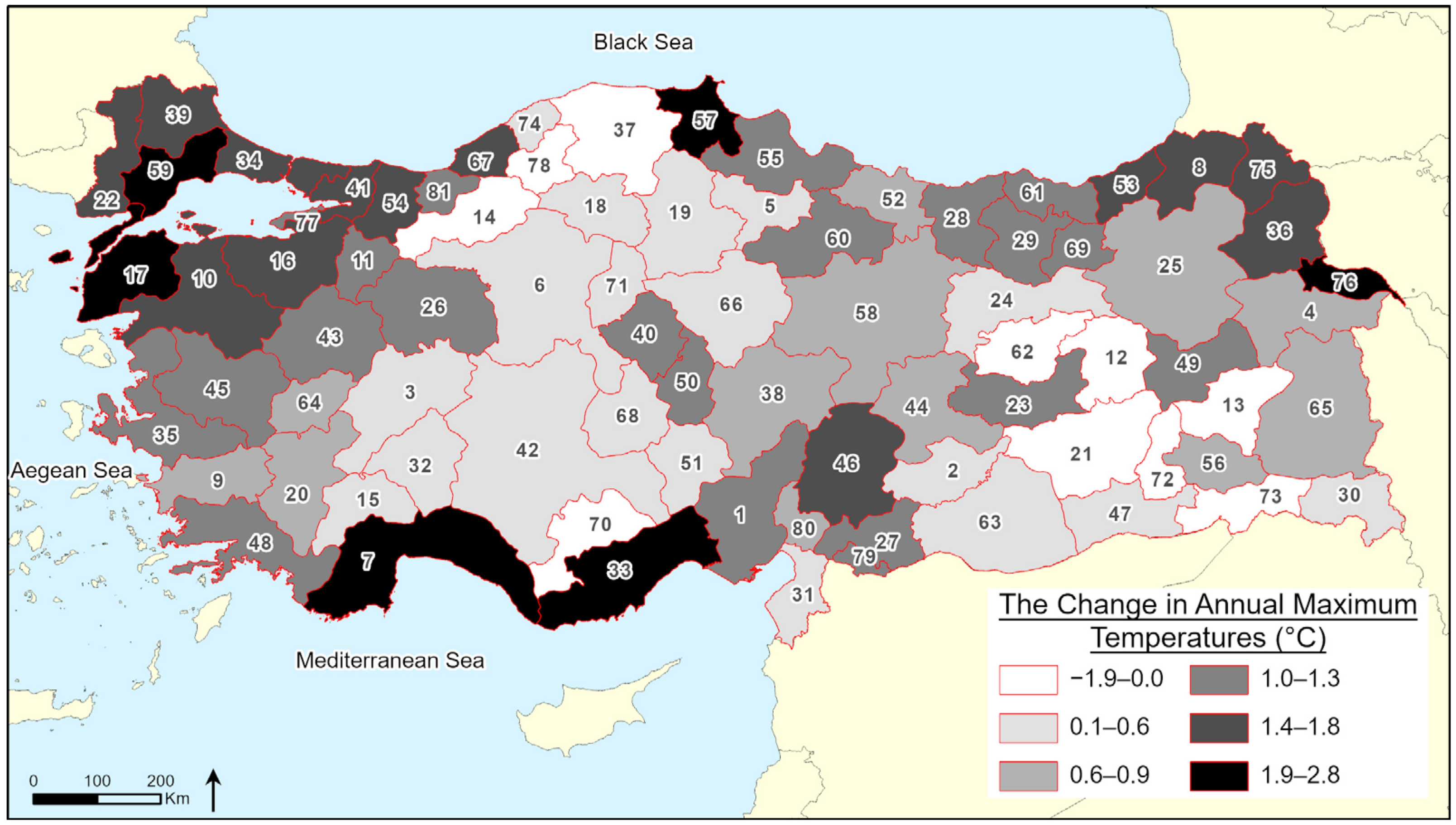
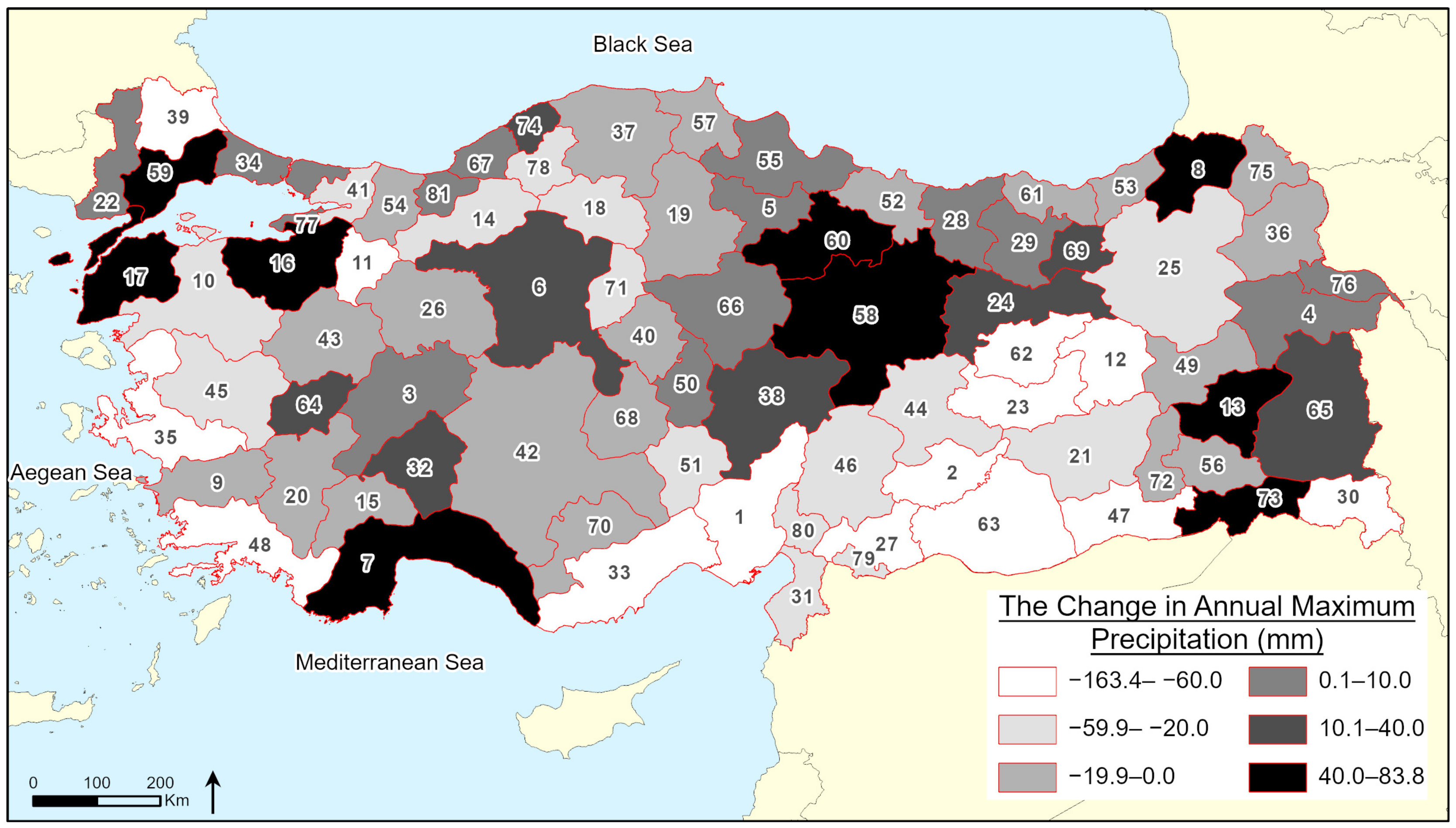
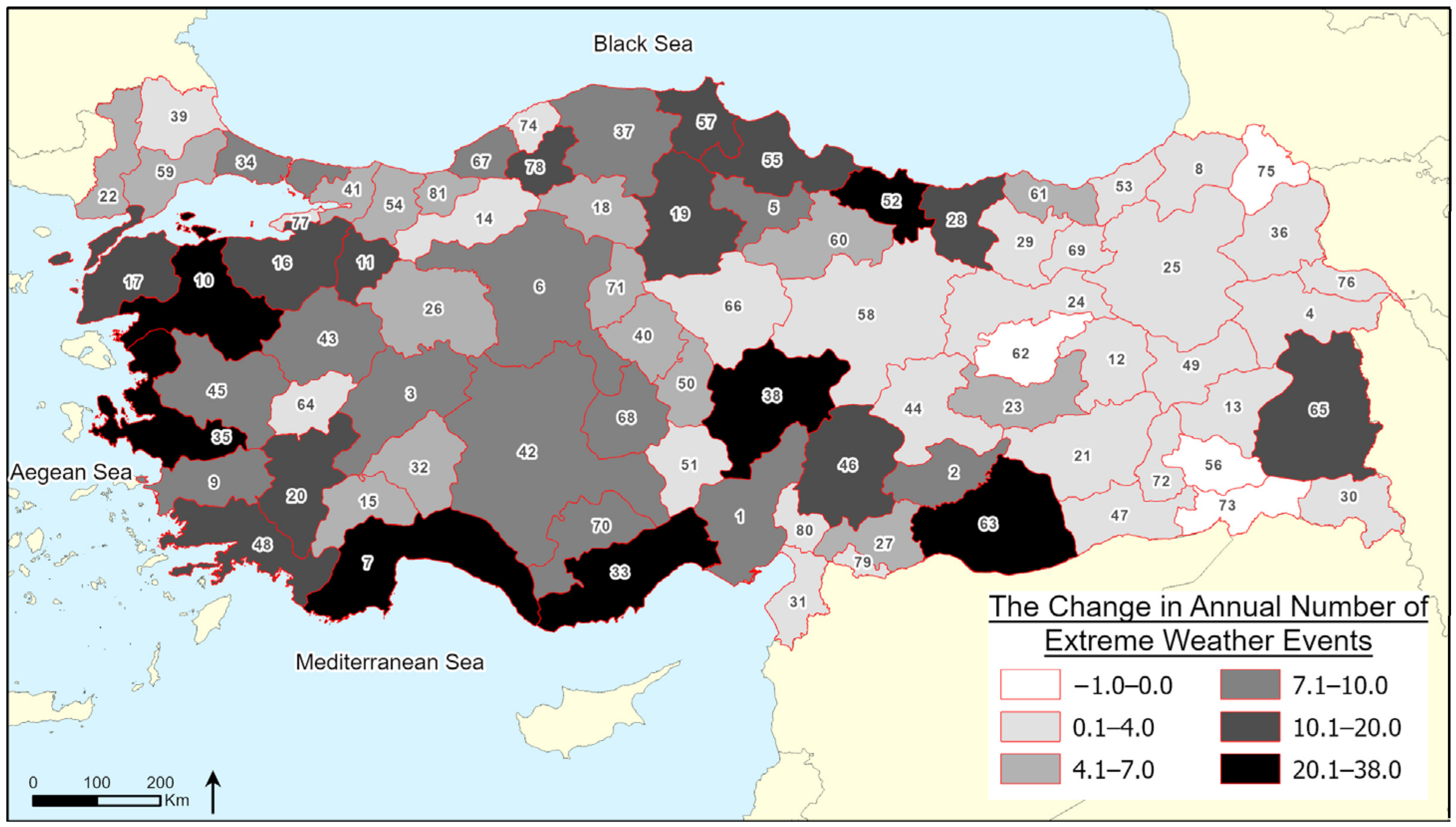

| SPI | Classification |
|---|---|
| 2.0 or higher | Exceptionally moist |
| 1.60 to 1.99 | Extremely moist |
| 1.30 to 1.59 | Very moist |
| 0.80 to 1.29 | Moderately moist |
| 0.51 to 0.79 | Abnormally moist |
| 0.50 to −0.50 | Normal |
| −0.51 to −0.79 | Abnormally dry |
| −0.80 to −1.29 | Moderately dry |
| −1.30 to −1.59 | Very dry |
| −1.60 to −1.99 | Extremely dry |
| −2.0 or lower | Exceptionally dry |
| Dependent Var. | Annual Mean Temperature | Annual Maximum Temperature | Annual Maximum Precipitation | Annual Number of Extreme Weather Events | Number of Dry Months per Year | |
|---|---|---|---|---|---|---|
| Independent Var. | ||||||
| Built Environment | R2 = 0.009 Sig = 0.420 | R2 = 0.063 Sig = 0.029 | R2 = 0.008 Sig = 0.435 | R2 = 0.158 Sig = 0.000 | R2 = 0.023 Sig = 0.196 | |
Disclaimer/Publisher’s Note: The statements, opinions and data contained in all publications are solely those of the individual author(s) and contributor(s) and not of MDPI and/or the editor(s). MDPI and/or the editor(s) disclaim responsibility for any injury to people or property resulting from any ideas, methods, instructions or products referred to in the content. |
© 2023 by the authors. Licensee MDPI, Basel, Switzerland. This article is an open access article distributed under the terms and conditions of the Creative Commons Attribution (CC BY) license (https://creativecommons.org/licenses/by/4.0/).
Share and Cite
Bektaş, Y.; Sakarya, A. The Relationship between the Built Environment and Climate Change: The Case of Turkish Provinces. Sustainability 2023, 15, 1659. https://doi.org/10.3390/su15021659
Bektaş Y, Sakarya A. The Relationship between the Built Environment and Climate Change: The Case of Turkish Provinces. Sustainability. 2023; 15(2):1659. https://doi.org/10.3390/su15021659
Chicago/Turabian StyleBektaş, Yasin, and Adem Sakarya. 2023. "The Relationship between the Built Environment and Climate Change: The Case of Turkish Provinces" Sustainability 15, no. 2: 1659. https://doi.org/10.3390/su15021659





